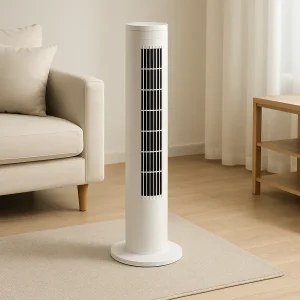Choosing the right fan for your space can feel overwhelming. With so many types—each claiming to offer efficiency—it’s easy to make a costly mistake. But when airflow, energy savings, and cost efficiency matter most, understanding fan types is your best solution.
The most efficient fan type depends on your space and purpose. For large areas, HVLS and centrifugal fans are the most energy-efficient. For homes or offices, ceiling fans, tower fans, and smart pedestal fans offer effective cooling with low energy use.

Industrial HVLS fans installed in warehouse ceiling
Fan efficiency isn’t just about speed or how strong the breeze feels—it’s about how much l'air qu'un ventilateur peut déplacer with the least amount of Consommation d'énergie. Efficiency varies based on:
Fans that déplacer l'air effectively while drawing minimal power reduce operating costs, improve comfort, and lower environmental impact. High-efficiency fans also produce less noise and last longer with proper care.
Key efficiency measures:
| Fonctionnalité | Efficient Fans Offer |
|---|---|
| Airflow Volume | High CFM rating for space coverage |
| Energy Use | Low wattage or energy star rated |
| Durabilité | Industrial-grade motor, bearings, and housing |
| Smart Control | Variable speed, motion sensor, or remote |
To make a smart decision, it’s essential to compare different types de ventilateurs and their efficiency across real-world applications.
ventilateurs centrifuges are commonly used in industrial settings where high pressure airflow is necessary. These fans pull air into the fan wheel and push it out at a 90-degree angle, creating high static pressure—ideal for ductwork, les systèmes de ventilation, et haute température environnements.
Why centrifugal fans work best:
However, centrifugal fans are usually larger, noisier, and more expensive than ventilateurs tour ou ventilateurs sur pied. They are efficient in specific environments, not for household cooling.
Explore how centrifugal fans work in large commercial setups
Ventilateurs axiaux, on the other hand, are widely used across applications—from cooling fan units in electronics to large-scale refroidissement industriel. They operate by moving air parallel to the fan blade axis and are best for situations needing high airflow at low pressure.
Axial fans tend to consume less energy when not battling pressure loads, making them more energy efficient in open spaces.
Tower fans are a popular choice in homes and offices due to their compact size, modern design, and oscillating airflow. Although they don’t produce high CFM like industrial fans, they faire circuler l'air well in small to medium rooms.
However, the vitesse du ventilateur and airflow power are limited compared to ventilateurs axiaux ou ventilateurs centrifuges. If you’re choosing a fan to cover large areas like entrepôts ou gymnases, tower fans are not the best option.

Slim tower fan for home use
Ventilateurs sur pied et ventilateurs de table are flexible and portable, making them perfect for temporary or personal cooling. These electric fans can be easily moved between rooms, adjusted for vitesse du ventilateur, and tilted to direct airflow.
While they offer decent energy savings and airflow direction control, pedestal and table fans are not designed to déplacer de grandes quantités d'air. They are not suitable for environments requiring strong, continuous ventilation or cooling.
Oui-ventilateurs de plafond remain one of the best ways to faire circuler l'air efficiently, especially in industriel ou commercial spaces with high ceilings. Their energy draw is minimal compared to climatisation units, and they help keep air chaud down in the winter and air frais moving in summer.
Modern ceiling fans, especially Ventilateurs HVLS (high-volume, low-speed), offer massive économies d'énergie. Ces les fans travaillent efficacement dans usines, gymnases, et centres sportifs, delivering comfort with low operating costs.
Discover how ceiling fans help cool large facilities
Bladeless fans are quieter and safer, with a futuristic design that draws air into the base and pushes it through a ring to air frais effectively. They’re best for homes or offices prioritizing safety and aesthetics.
Smart fans, whether tower or piédestal, integrate with apps and voice assistants, allowing users to set timers, schedules, and speed automatically. They offer convenience and efficacité énergétique when cooling is needed in short bursts.
However, these fans are often costly and are more suited to personal use rather than ventilateurs industriels needs. For large facilities, centrifuge ou Ventilateurs HVLS remain the best options.
Quand il s'agit de refroidissement industriel, only certain types de ventilateurs meet the demand for volumes d'air, low noise, et long-term durability.
Chaque type de ventilateur has specific applications. For example, ventilateurs centrifuges poignée haute température, service continu operations. Ventilateurs HVLS sont idéales pour cooling your home or business efficiently without high energy bills.

ventilateur hvls dans un grand entrepôt
When selecting a fan to move air across wide or tall areas, it’s important to consider conception du ventilateur, pale de ventilateur size, and application. Here’s how some different types of fans compare:
| Type de ventilateur | Idéal pour | Efficacité | Couverture |
|---|---|---|---|
| Tower fan | Bedrooms, offices | Modéré | Small |
| Ventilateur sur pied | Personal cooling | Good | Moyen |
| Ceiling fan / HVLS fan | Warehouses, gyms | Excellent | Very large |
| ventilateur centrifuge | Industrial exhaust | Haut | Haute pression |
| ventilateur axial | General ventilation | Haut | Wide area |
| Smart fan | Homes, offices | Good | Small to medium |
| Bladeless fan | Safety and style | Modéré | Small |
Axial fans move air in a straight path, making them great for continuous climatisation or supply needs. ventilateurs centrifuges pull air into the center and push it out at a 90-degree angle, useful in high-pressure, ducted systèmes.
Ventilateurs HVLS (haut volume, basse vitesse) représentent le summum de ventilateur industriel engineering. These large ventilateurs de plafond span up to 24 feet and déplacer l'air gently but thoroughly across vast spaces.
These fans are not just about airflow—they impact your facility’s overall Consommation d'énergie, confort, et operating costs. Compared to traditional climatiseur units, HVLS fans provide better ROI, especially when paired with smart controls.
Explore more: HVLS fans for commercial applications
Un energy-efficient fan balances flux d'air with minimal power usage. This depends on:
To achieve économies d'énergie, many businesses switch from electric fans et air conditioners to HVLS or ventilateurs centrifuges for long-term savings.
Choisir le ventilateur droit depends on your specific space and needs. Ask:
If you manage a facility such as a entrepôt, salle de sport, ou usine, the right answer is almost always an ventilateur industriel like HVLS or centrifuge types.
How to select the best HVLS fan for your factory
Which type of fan is most energy-efficient?
The most energy-efficient fan is the HVLS (High Volume Low Speed) fan for large commercial or industrial spaces. For residential settings, ventilateurs de plafond avec Energy Star certification and brushless DC motors offer excellent efficiency.
What is the difference between axial and centrifugal fans?
Ventilateurs axiaux move air in a straight line and are best for moving large volumes at low pressure. ventilateurs centrifuges, on the other hand, are designed to generate higher pressure and are ideal for ducted ou ventilateur d'extraction systèmes.
Do fans really help with air conditioning efficiency?
Yes. Fans, especially ventilateurs de plafond, help faire circuler l'air and reduce hot or cold spots. This lets you raise the thermostat in summer or lower it in winter, reducing Consommation d'énergie without sacrificing comfort.
Are bladeless fans worth it?
Bladeless fans offer safety, quiet operation, and modern design. However, they typically déplacer moins d'air than traditional pale de ventilateur models and may not be ideal for refroidissement industriel.
Which fan works best for gyms or sports centers?
Grand Ventilateurs HVLS are the best option. They cover wide areas, faire circuler l'air efficiently, and provide refroidissement without noisy operation, making them ideal for athletic facilities.
How often should I maintain industrial fans?
It’s recommended to follow a strict calendrier d'entretien: check for vibration, lubricate bearings, inspect moteur health, and clean the pales de ventilateur every 3–6 months for optimal performance.
To wrap up, here’s what you need to remember when choosing the most ventilateur efficace for your space:
Whether you’re managing a usine, outfitting a commercial gym, ou installing ventilation in a entrepôt, selecting the right type de ventilateur ensures better comfort and efficacité énergétique.

Salut, je suis Michael Danielsson, PDG de Vindus Fans, avec plus de 15 ans d'expérience dans le secteur de l'ingénierie et de la conception. Je suis ici pour partager ce que j'ai appris. Si vous avez des questions, n'hésitez pas à me contacter à tout moment. Grandissons ensemble !